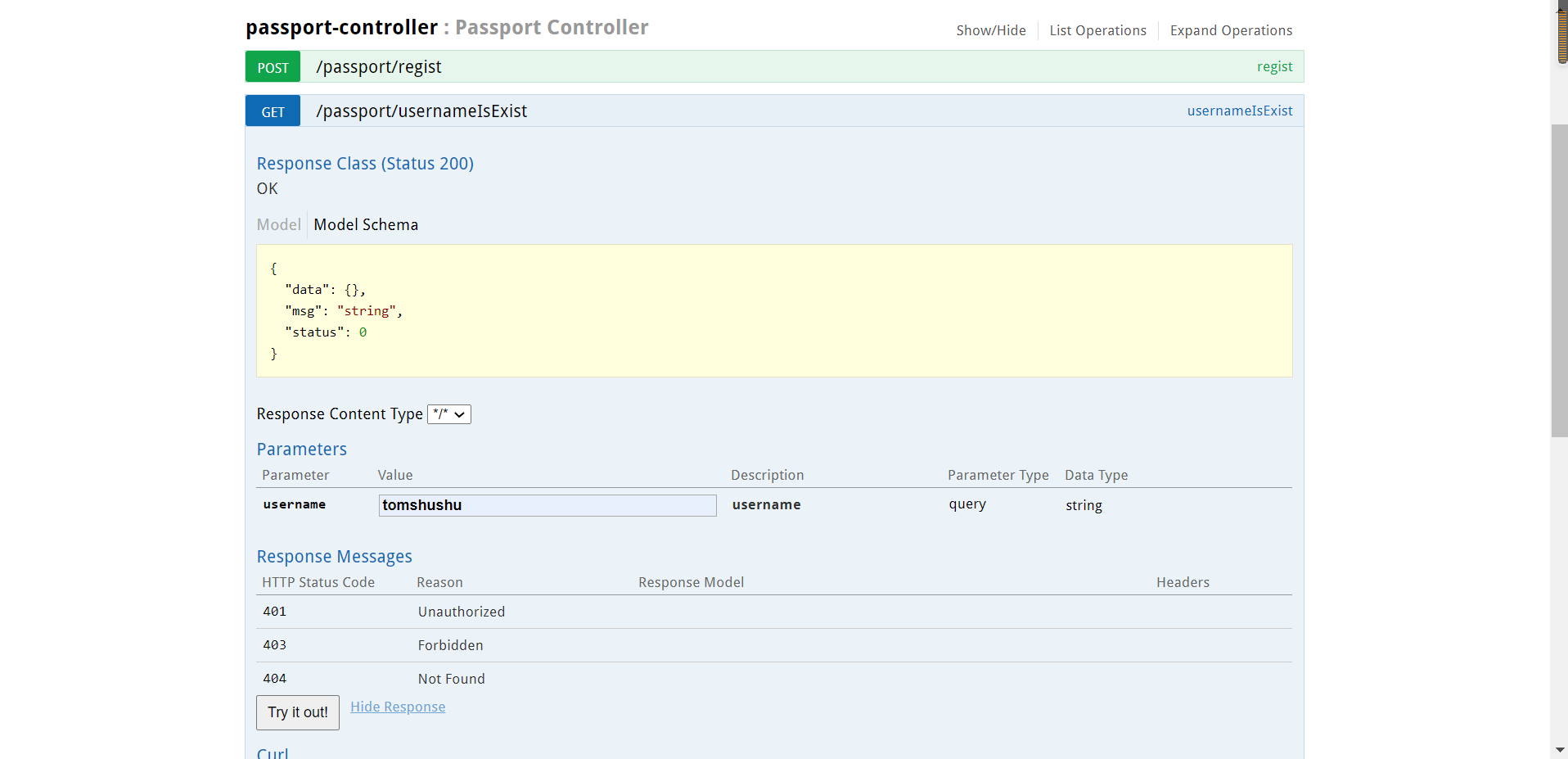SpringBoot集成Swagger2
一、是什么
当下很多公司都采取前后端分离的开发模式,前端和后端的工作由不同的工程师完成。在这种开发模式下,维持一份及时更新且完整的 Rest API 文档将会极大的提高我们的工作效率。传统意义上的文档都是后端开发人员手动编写的,相信大家也都知道这种方式很难保证文档的及时性,这种文档久而久之也就会失去其参考意义,反而还会加大我们的沟通成本。而 Swagger 给我们提供了一个全新的维护 API 文档的方式。
二、为什么要使用它
1、代码变更,文档跟着代码变、只需要少量的注解Swagger就可以根据代码自动的生成API文档,很好的保证了文档的实时性。
2、跨语言,Swagger支持40多种语言。
3、Swagger UI 呈现出来的是一份可以交互的API文档,我们可以直接在文档页面尝试API的调用,省去了准备复杂的调用参数的过程。
4、还可以将文档规范导入相关的工具里面(例如:Postman、SoapUI)、这些工具将会为我们自动地创建自动化测试。
三、怎么用
1、在项目pom.xml里面加入Swagger2相关的依赖
<!--swagger2配置--> <dependency> <groupId>io.springfox</groupId> <artifactId>springfox-swagger-ui</artifactId> <version>2.4.0</version> </dependency> <dependency> <groupId>io.springfox</groupId> <artifactId>springfox-swagger2</artifactId> <version>2.4.0</version> </dependency> <dependency> <groupId>com.github.xiaoymin</groupId> <artifactId>swagger-bootstrap-ui</artifactId> <version>1.6</version> </dependency>
2、新建Swagger2的配置类
package com.zhouhong.config; import org.springframework.context.annotation.Bean; import org.springframework.context.annotation.Configuration; import springfox.documentation.builders.ApiInfoBuilder; import springfox.documentation.builders.PathSelectors; import springfox.documentation.builders.RequestHandlerSelectors; import springfox.documentation.service.ApiInfo; import springfox.documentation.service.Contact; import springfox.documentation.spi.DocumentationType; import springfox.documentation.spring.web.plugins.Docket; import springfox.documentation.swagger2.annotations.EnableSwagger2; /** * @ClassName: Swagger2 * @Description: * @Author: 周红 * @NickName: Tom-shuhu * @Date: Created in 2020/12/15 **/ @Configuration @EnableSwagger2 public class Swagger2 { // http://localhost:8088/swagger-ui.html 原路径 // http://localhost:8088/doc.html 原路径 //配置swagger2核心配置 @Bean public Docket createRestApi(){ return new Docket(DocumentationType.SWAGGER_2) //指定api类型位swagger2 .apiInfo(apiInfo()) //用于定义api文档汇总信息 .select().apis(RequestHandlerSelectors .basePackage("com.zhouhong.controller")) //指定生成文档的controller .paths(PathSelectors.any()) .build(); } private ApiInfo apiInfo(){ return new ApiInfoBuilder() .title("Tom-shushu 的项目接口api") //文档标题 .contact(new Contact("周红", //作者 "www.zhouhong.icu", "15249239025@163.com")) //联系人 .description("Tom-shushu 的项目api接口")//详细信息 .version("1.0.0")//文档版本号 .termsOfServiceUrl("www.zhouhong.icu")//网站地址 .build(); } }
文档配置说明:
a.为任何接口生成API文档,这种方式不必在接口方法上加任何注解,方便的同时也会因为没有添加任何注解所以生成的API文档也没有注释,可读性不高。
@Bean public Docket createRestApi(){ return new Docket(DocumentationType.SWAGGER_2) .apiInfo(apiInfo()) .select() //为任何接口生成API文档 .apis(RequestHandlerSelectors.any()) .paths(PathSelectors.any()) .build(); }
b.为当前配置的包下controller生成API文档
.apis(RequestHandlerSelectors.basePackage("com.troila"))
c.为有@Api注解的Controller生成API文档
.apis(RequestHandlerSelectors.withClassAnnotation(Api.class))
d.为有@ApiOperation注解的方法生成API文档
.apis(RequestHandlerSelectors.withMethodAnnotation(ApiOperation.class))
三、常见注解简介
@Api:修饰整个类,描述Controller的作用
@ApiOperation:描述一个类的一个方法,或者说一个接口
@ApiParam:单个参数描述
@ApiModel:用对象实体来作为入参
@ApiProperty:用对象接实体收参数时,描述对象的一个字段
@ApiResponse:HTTP响应其中1个描述
@ApiResponses:HTTP响应整体描述
@ApiIgnore:使用该注解忽略这个API
@ApiError :发生错误返回的信息
@ApiImplicitParam:一个请求参数
@ApiImplicitParams: 多个请求参数
四、演示(为方便我使用了上面第一种配置)
1、使用原路径访问

2、原路径调试

3、doc模式访问

4、doc模式调试

本文来自博客园,作者:Tom-shushu,转载请注明原文链接:https://www.cnblogs.com/Tom-shushu/p/14140925.html






【推荐】国内首个AI IDE,深度理解中文开发场景,立即下载体验Trae
【推荐】编程新体验,更懂你的AI,立即体验豆包MarsCode编程助手
【推荐】抖音旗下AI助手豆包,你的智能百科全书,全免费不限次数
【推荐】轻量又高性能的 SSH 工具 IShell:AI 加持,快人一步
· 基于Microsoft.Extensions.AI核心库实现RAG应用
· Linux系列:如何用heaptrack跟踪.NET程序的非托管内存泄露
· 开发者必知的日志记录最佳实践
· SQL Server 2025 AI相关能力初探
· Linux系列:如何用 C#调用 C方法造成内存泄露
· 震惊!C++程序真的从main开始吗?99%的程序员都答错了
· 【硬核科普】Trae如何「偷看」你的代码?零基础破解AI编程运行原理
· 单元测试从入门到精通
· 上周热点回顾(3.3-3.9)
· winform 绘制太阳,地球,月球 运作规律